My shopping cart
Your cart is currently empty.
Continue Shopping
Thai cuisines are varied in tastes and styles from region to region depending on the geography and history of each part of the country. In addition, other culinary influences, local ingredients, ways of life as well as cooking techniques, all of these helps differentiate and characterize each regional cuisine.
We want to take you on a journey through the story of the local cuisines which may inspire you for your next trip to Thailand or your next meal.
Let’s start with the North of Thailand!

In terms of its geography, the North of Thailand was isolated from Bangkok and the rest of Thailand due to its mountainous terrain. And historically, the region was home to the ancient Lanna Kingdom which was not part of Siam (Thailand) until the 19th century.
This allowed the Northern region to develop its own culture and cuisine distinguished from other regions.
However, as it was located closer to Burma (Myanmar) and China, the Kingdom became a trading center and crossroads of cultures in the region, so Lanna cuisine was also influenced by Burma, Laos, China, and India.
The weather also plays an important role, the cool climate all year round in this region inspires dishes which use ingredients that keep the body warm and boost energy. Pork belly, pork knuckle, pork skin as well as herbs and spices that raise your body temperature like ginger and garlic are some examples. This mountainous region is abundant with wild mushrooms, forest vegetables and fruits which are unique to the North and locals use them to create some exclusive-to-local dishes. However, this also make them less known to the rest of the country as well.

The Lanna food palate in general is salty, mildly hot, and not so sweet, with smoky grill and herb-rich aroma. They usually serve with streamed sticky rice and a lot of fresh vegetables.
If you feel like having a Lanna dining experience while visiting the North of Thailand, you should find space in your diary for a Khan Tok dinner at a local restaurant (not everywhere serves this, but it is not difficult to find).
Khan Tok is a traditional Lanna style of a dining set serving to welcome guests or on special occasions. The name is taken from the small dining tray or table it is served on. About 5-6 local dishes in small portions will be served together on one table, the classic dishes you will usually find are steamed sticky rice with local styles of dips like Nam Phrik Ong or Nam Phrik Num pairing with seasonal local vegetables. The main dishes include Larb Kua, Neam, Kaeng Om or Kaeng Kanun, Sai Oua. Khaep Mu and Kaeng Hangle.
Khan Tok dinner at the restaurant is usually combined with Lanna style dances or special shows, so you can get the full local experience in one meal.
There is a wide array of options for Northern Thai cuisine, but here are 10 dishes that we think you should put at the top of your list:
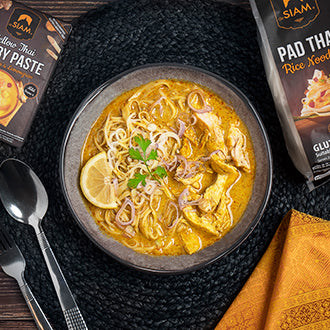
This is one of the most well-known and beloved Lanna dishes so it is the perfect place to start your food journey. Khao Soi is a mild, coconut based yellow curry served over soft egg noodles with chicken, pork, or beef.
It is usually topped with crisp egg noodles with optional additions of lime, shallot, pickled mustard greens, and chili. The dish is creamy, salty, and mildly hot.
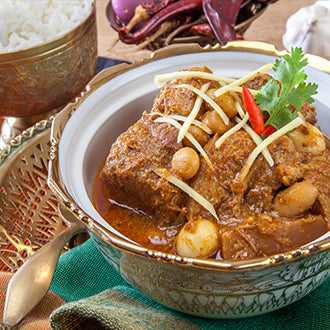
Influenced by Burmese cuisine, Kaeng Hungley is a tender, stewed pork curry which is made from pork belly, a mild spice mixture, and flavored with ginger, turmeric, and tamarind.
The original recipe of this curry dish does not contain coconut milk like other curries, but the modern recipe might add the coconut milk to make it thicker and creamier. The curry palate is a balance of three flavors - salty, sweet, and mild spicy.
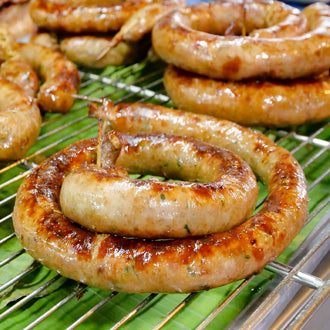
The Northern style pork sausage, or commonly known among foreigners as Chiang Mai sausage, is distinguished from other Thai sausages with its rich in herbs and spices.
This Northern Thai specialty is infused with minced pork, dried chili, lemongrass, kaffir lime leaves, shallots, and galangal. Traditionally charcoal grilled which added smoky, rich, and deep aroma and flavor to the savory sausage that is totally addictive.
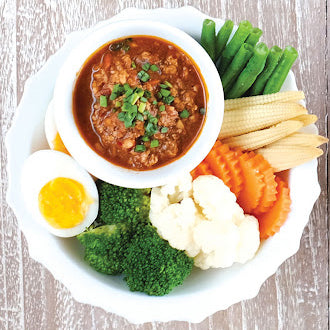
It is called Nam Phrik or chili dip in Thai, but Nam Phrik Ong is probably the mildest chili dip of all. The dip has a combination of salty, sweet, and slightly sour flavors.
It is commonly made with minced pork, chili paste, and tomatoes, which is the main ingredient that gives it a red look, despite not being spicy at all. Usually served with seasonal vegetables.
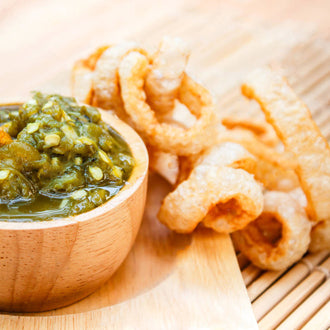
Nam Phrik Num is a green chili dip and Khaep Mu is a pork crackling in Thai. The green color of this chili dip might make you think it is not spicy, but your tongue will tell a different story to your eye. Nam Phrik Num is made from roasted green chili peppers, garlic, shallots, and cloves and usually offers spicy palate from mild to medium level.
So if your spicy food tolerance is low, be careful when you take the dip.
However, when eating with Khaep Mu, the pork cracklings can help reduce the spiciness while the dip complements the taste of the pork cracklings – a perfect combination. The dip can also pair with raw or cooked vegetables.
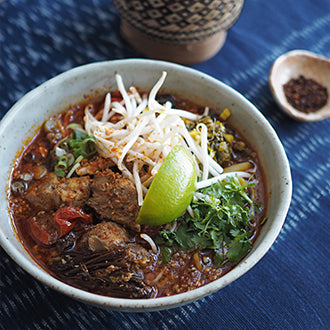
This noodle dish is a combination of rice noodles, pork, tomatoes and topped with fried garlic, chili, pickled mustard greens, and bean sprouts. What makes this Northern specialty unique is the broth made from tomatoes, a dried local flower called Dok Ngiew, and cubes of pork blood.
The dish has a mix of salty, sweet, and sour flavors and is normally not spicy, unless you add dried chili for some kick.

Kaeng Ho or Stir-fry Curry Glass Noodles in Thai. The word ‘Ho’ in Northern Thai means ‘mix or put together’ which refers to how the locals create this dish - they usually mix other dishes together to make a new one, so the leftovers do not go to waste.
The common ingredients of this recipe are usually taken from leftover Hangle curry and stir-fry with glass noodles, then add kaffir lime leaves, bamboo shoots, lemongrass, and pork. However, now most Kaeng Ho prepared at the restaurants uses fresh ingredients for hygiene and nutritional benefits. The dish palate is quite strong and mild to middle spicy.
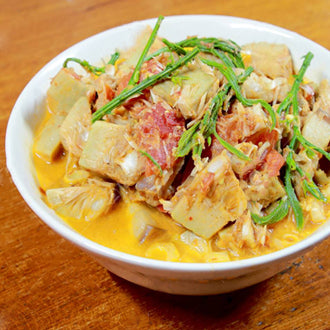
Kaeng Khanun or unripe jackfruit curry is a special creation from the North which is rarely found elsewhere in Thailand. The name in Thai contains good meanings, so locals like to make it for wedding ceremonies or Thai new year celebrations. It is called curry, but it is more of a soup than a curry because no curry powder or coconut milk is used in this dish.
It is equivalent to Tom Yam, in terms of hot and sour soup, but offers a different flavor. A blend of unripe jackfruit, cherry tomatoes, local herbs and pork, create a unique savory taste. It might not be everyone’s favorite but it can give you an exclusive-to-local taste and experience.
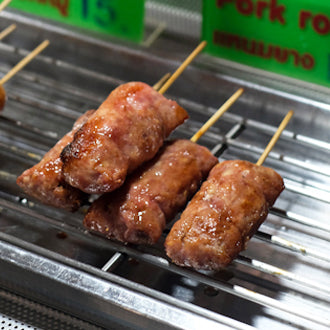
Naem is a fermented pork sausage in Thai cuisine with a sour flavor. You can find Naem nearly everywhere in Thailand, but the Northern style fermented pork called ‘Naem Moo’ is Chiang Mai’s specialty and is quite distinguished from other sausages. The different ingredients, especially thin sliced pork skin and fat, and local seasoning as well as how they prepare and ferment pork meat in a pot, made the taste and texture different and worth trying when you have the chance.
Naem Moo usually comes in a free form and one big piece depending on the pots or containers that the vendors use, not a plastic tube or banana-leaf wrap like other sausages, and can be cut in to a smaller piece for sell by order. It can be eaten raw or cooked, and paired with roasted peanut, ginger, and chili.

This dish is like a Larb dish of Isan cuisine which is a spicy and sour minced pork salad, but the Lanna style uses pork blood and a unique blend of local dried spices and cook the mixture by stir-fry (Kua in Northern dialect).
The dish has strong taste, medium spicy, and is rich in herb and spice aroma.